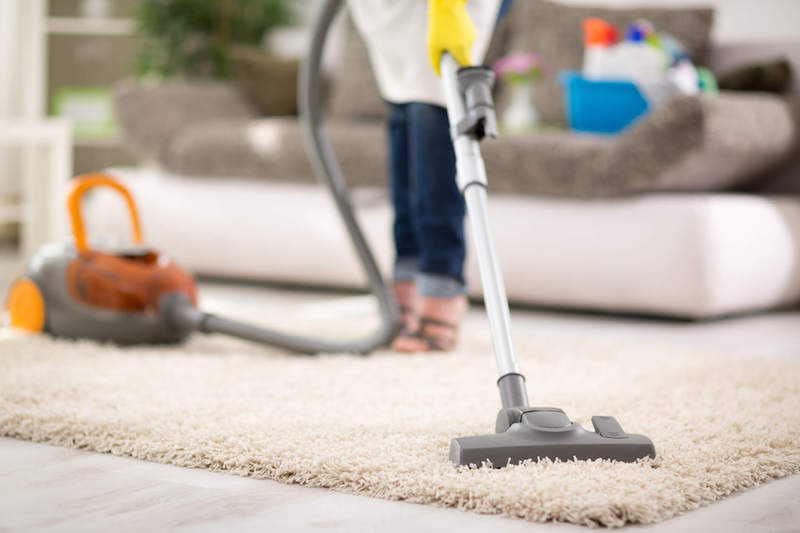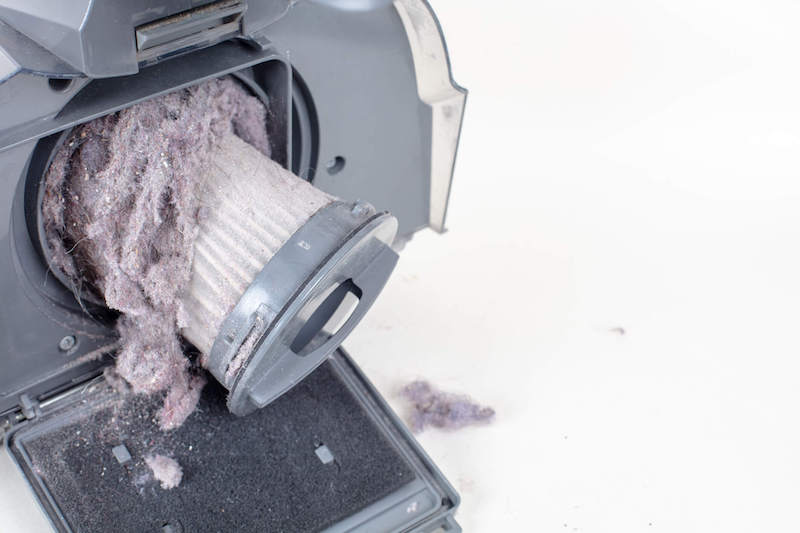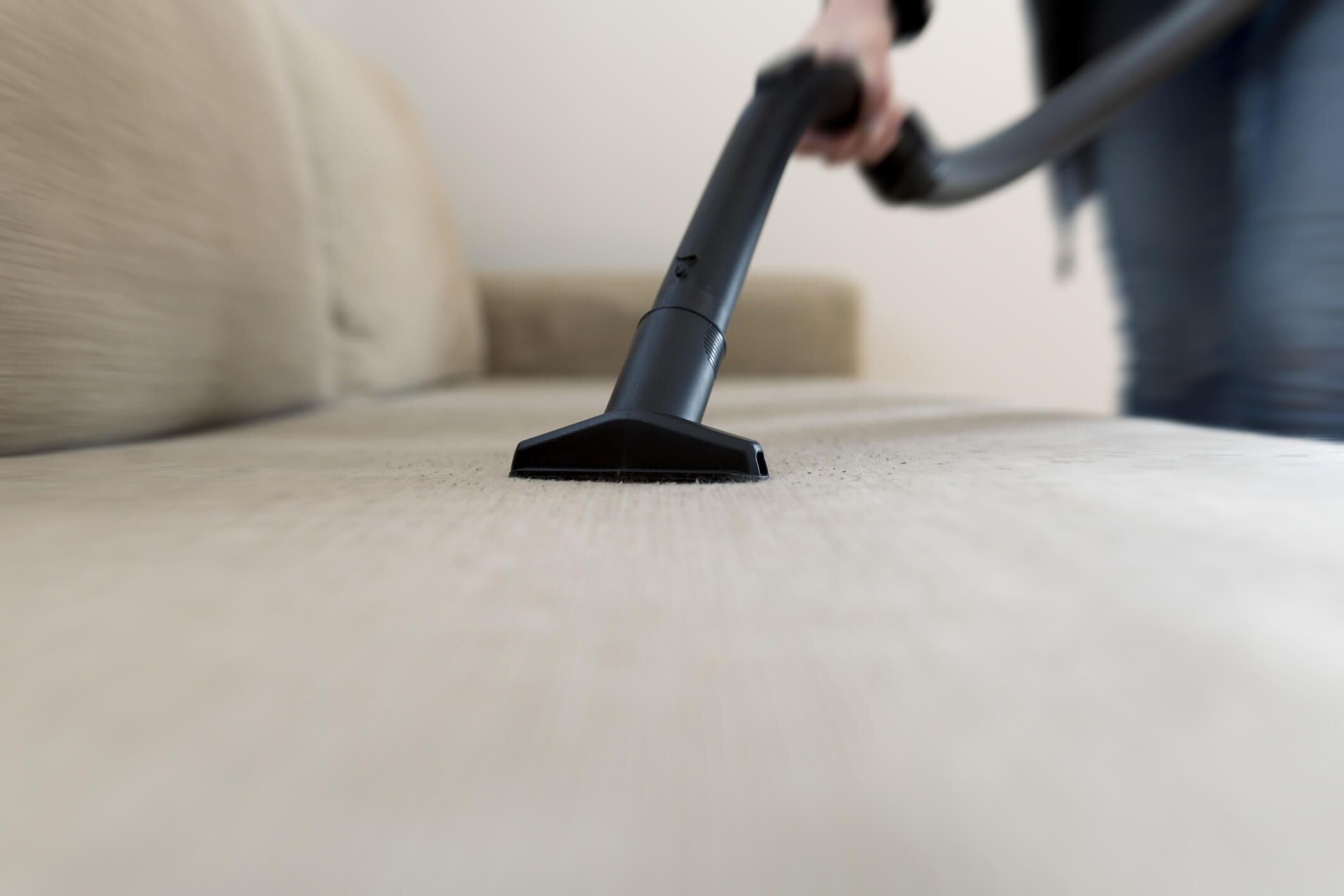Emptying a vacuum cleaner canister or taking a look inside the bag is... gross. There’s no getting around it! It’s filled with all of the dirt, dust, hair, and who knows what else that was just hanging around your home and living alongside you. Do you ever wonder, though, what gets left behind?
The truth is, not all vacuum cleaners are created equal. Some leave behind particles or, even worse, circulate them into the air you’re breathing in. That’s not exactly the results we’re looking for when we’re taking on a deep-cleaning day.

To make matters worse, it’s not just the fact that our homes can remain dirty. Failing to remove particles can also have serious health implications. When tiny particles like mold spores are left behind or sent out into your indoor air, it can give your body’s immune system a serious headache. It can also give you a headache! That's why you need a machine with the capability to remove as many small particles as possible, so your vacuuming wasn’t in vain, which is especially devastating for those of us who hate this chore! That’s where HEPA vacuum cleaners come in. These phenomenal tools help ensure our indoor spaces aren’t filled with crazy amounts of invisible particles.
When it comes to handling indoor mold problems, in particular, or preventing them from starting in the first place, this machine is a must. The only downside is that it can’t operate itself, so we still have to keep vacuuming on that long list of chores!
What's Special About HEPA Vacuum Cleaners?
The magic and usefulness of HEPA vacuum cleaners boil down to the technology behind their filters. Vacuums utilize airflow to suck up particles and transfer them into the canister or bag attached. Once here, that air gets pulled out of that storage area, transferred through a filter, and pushed back out of the machine. This filter helps ensure that all of the particles the vacuum just removed aren’t just released back into the air and directly inhaled by you, the vacuum-er.
The filtration portion of the machine is what sets HEPA vacuums apart. While other machines will filter out a majority of smaller particles, they don’t have the capability to stop some of those ultra-fine and invisible specks that exist in your home. The word "HEPA" actually stands for "high-efficiency particulate air" and refers to the filter itself.
While the filters can come in a variety of materials, the tightly pleated design gives them the distinct capability of removing many microscopic particles from an indoor space. You can actually get HEPA filters for other gadgets like air filters and larger-scale things like HVAC systems.
To reach the EPA standard and be qualified as a HEPA filter, they must filter out 99.7% of particles that pass through that are 0.3 microns in size.¹ That’s teeny tiny! To put it into perspective, the size of a single piece of fine sand is around 125 microns.

Other vacuum cleaner filters aren’t designed to remove particles that small at such a high rate, meaning that while they might stop some things as small as 0.3 microns, it might only happen 30 percent of the time. That means that 70% of the time, those particles will pass right through the vacuum and back into your air or onto another surface. That not only leads to a failed vacuuming job (there are contaminants still all over the home) but can also cause you or anyone in the home to develop adverse health reactions. When those tiny specks are mold spores, mold fragments, bacteria, or other symptom-inducing particulates, this is a serious cause for concern.
Why Size Matters
Most of the particles we're talking about removing, you can’t see. The average human eye can only view particles around 40 microns in size or larger. To help put it into perspective, remember that a strand of hair is around 70 microns. It's not quite squint-worthy, but it's close! A single micron is one-millionth of a meter. A better visual may be to picture 1,000 microns lined up in a row—that equals exactly one millimeter (the super small lines on rulers).

Why is this important to know and understand? In the current day and age, most of us have heard of the harmful effects of particulate matter, but it’s usually regarding pollution in the air outside. Particulate matter doesn’t just exist outdoors, though. It can affect the indoor air quality right in our own homes.
The harmful impact of particulate matter is due to its ability to be inhaled. The EPA categorizes these particles into two groups:²
- PM₁₀: particles with diameters of 10 micrometers (microns) or less
- PM₂.₅: fine particles with diameters of 2.5 micrometers or less
Now factor in that the average human takes 20,000 breaths a day, and most of those are taken right inside of our own homes. ³
If that indoor air is filled with particulate matter, or if these particles are hanging out on surfaces like the floor and curtains, there’s ample opportunity for them to begin affecting your health as they make their way inside of your body. The immune system will tag them as foreign invaders and wage a war to remove them and keep the body healthy.
Mold spores are an example of these foreign invading particles. They’re small enough to make their way inside of your lungs, and sometimes even into your bloodstream. Depending on the person exposed, this can cause a long list of symptoms. Some individuals, like those with compromised immune systems, pre-existing conditions, allergy sensitivities, and developing immune systems, are particularly prone to developing adverse reactions ranging from mildly irritating to more severe. ⁴’⁵’⁶
These symptoms can include:
- Headache
- Sniffles
- Coughing
- Chronic Fatigue
- Brain Fog
- Digestive Issues
- Respiratory Problems
- Neurological Issues

Removing the particles from the environment by using technology like HEPA vacuum cleaners reduces this exposure and creates a healthy indoor environment that won’t trigger health reactions. It also just leads to a healthier, cleaner, and safer indoor space.
HEPA Vacuum Cleaners and Mold
There are quite a few reasons why HEPA vacuum cleaners are rockstar cleaning tools, but mold removal is at the top of the list. If you’re dealing with mold or looking to get rid of any random spores that might have made their way inside of your home, HEPA vacuum cleaners will be one of your best friends.
Mold reproduces by creating microscopic spores that it releases into the air, similar to a dandelion puff releasing its seeds. The key distinction between mold and a dandelion puff is the size of the spores the colonized mold produces. Most mold spores are between 1 and 20 microns in size. That means that these tiny seed-like particles are floating all over and are invisible to the naked eye. Considering there are over 100,000 species of mold identified so far, it’s safe to say these spores are everywhere. ⁷’⁸

Most of the time, these spores don’t cause a problem. Mold is actually incredibly beneficial to the natural world by helping break down dead organic matter. You’ll probably encounter a few spores throughout your everyday life, either hanging out in your car, walking into work, or even petting your dog’s fur. A few random spores encountered here and there cause no issues. The trouble arises when one of these spores finds a habitable place inside your home and begins to colonize the area.
That colonized mold will then continually release more and more spores into the air, tanking your indoor air quality and increasing the likelihood of more moldy opportunities. Some species of mold can also create microscopic toxins called mycotoxins that they release into the air as well. ⁹
This exposure can cause a long list of adverse health reactions, particularly for those with compromised or developing immune systems, as mentioned earlier. Everyone, though, can fall victim to the effects of mold exposure and develop symptoms, so it’s best for everyone to focus on removing them.
These spores will also stick to any surface they come in contact with, which is where a HEPA vacuum comes into play.
When you have a mold problem, removing the contamination will be your top priority, whether you’re tackling removal one step at a time when you’re able or are in the cleaning process after remediation. A huge portion of this cleaning and removal process includes continually vacuuming surfaces to remove mold spores. With spores ranging from 1–20 microns, that’s well within the limit of particle sizes that a HEPA vacuum cleaner can efficiently filter out.
Removing these spores helps decrease the chance that they’ll find other habitable areas to begin colonizing, and reduces the amount of exposure you and your family experience.
On the other hand, if you’re just looking to prevent mold from growing in your home, getting a vacuum cleaner that can remove any stray spores that managed to make their way inside your home is a must! That way, they can’t stumble across a wet or slightly damp area and start to grow.¹⁰ All it takes is 24-28 hours for a mold spore to make your home its new dream home.
Picking a HEPA Vacuum Cleaner
Like most things in the world, there is a lot of false advertising out there regarding HEPA vacuum cleaners. One of the main culprits for misinformation is whether or not the filter is HEPA quality. Remember, a HEPA filter should filter out particles as small as 0.3 microns 99.7% of the time. Not 65% of the time! Some companies will falsely label their vacuums as HEPA systems when, in actuality, they’re not.
When choosing your new machine, make sure to check the serial number and test results for the HEPA filter being used. Some brands will promote their vacuums as having HEPA filters when, in actuality, they don’t. It’s an additional pain, but we want to make sure you’re using the right technology.
The vacuum structure itself should also be a factor. You could have the best HEPA filter in the world, but if the vacuum body is improperly designed or the suction system operates poorly, you’re not getting the amount of cleaning power you’re looking for. This can lead to air either not being pushed through the filter and escaping elsewhere (with those harmful particles) or not having enough energy to pull the particles from the carpet and into the machine. The model you go with should have a sealed system, proper suction capabilities, and the filter should fit firmly in place.
After checking into these two important aspects, the rest is up to you! I personally recommend Nilifisk, particularly the Euroclean, as their technology is top of the line and I’ve experienced phenomenal success with their HEPA vacuum cleaners throughout my career.
Using A HEPA Vacuum Cleaner
Use is almost as important as choosing the right vacuum cleaner. You can buy the most expensive machine on the market, but if you’re not using it correctly or it’s improperly maintained, harmful particles like mold spores can get left behind and will continue to exist in the home. Plus, all of that cleaning would have been for nothing!
To get the most out of your machine, make sure to keep up with its maintenance. Every machine is different, so read through the manufacturer’s instructions for a detailed list of what your vacuum needs for optimum performance as well as timelines for when parts like the filter need to be replaced. While those HEPA filters often last for a while, they’re going to get full of harmful particles and need to be changed with a clean one.
When it comes to using the vacuum itself, make sure to slowly and methodically go over every area of the floor. Invisible particles like mold spores can end up anywhere and everywhere, especially if there’s mold growing inside a home and releasing spores. You want to make sure that the vacuum has enough time to pull up those particles and ensure you don’t miss any spots where those particles can be hiding.
Speaking of hiding, don’t forget to use the attachment features of the HEPA vacuum cleaner on other surfaces like couches, curtains, windowsills, and any other surface you can reach. Particles like mold spores don’t just sink to the ground; they stick to any surface they come into contact with. Running the vacuum attachment over these surfaces further removes any contamination from the indoor space that can potentially affect your health.

The cleaner the better, especially if you or anyone else in the home is prone to developing symptoms from exposure. If you or anyone else in the space is more sensitive to particulate matter, using an air filter while vacuuming can help make sure that any particles kicked up while cleaning are removed from the air while you’re cleaning the surfaces. That way, your cleaning packs a double whammy for removing particles from the home.
HEPA is Betta
At the end of the day, whether you’re looking for a cleaner house, removing contaminants like mold spores, or just creating a safer space, HEPA vacuums are a valuable tool to have in your arsenal. A dirty house doesn’t always look like those haunted house movies with dust and cobwebs everywhere. Sometimes, a dirty house is filled with invisible particles all over the surfaces of the indoor space.

That’s why having a system that can properly remove and filter out these particles is crucial. Moving around in a space filled with tiny particles is a health hazard waiting to happen, especially as they get kicked up into the air. Creating an indoor environment with better air quality and surfaces not contaminated with things like mold spores helps you and your family live healthier, happier lives. And, for the clean-o-holics out there, it will allow you to put your mind at ease that your home is spick and span!
It’s pretty much a win-win for all and absolutely worth the investment.
Citations:
- EPA. (n.d.). What is a HEPA filter? EPA. Retrieved November 16, 2021, from https://www.epa.gov/indoor-air-quality-iaq/what-hepa-filter-1.
- EPA. (n.d.). Health and Environmental Effects of Particulate Matter (PM). EPA. Retrieved October 8, 2021, from https://www.epa.gov/pm-pollution/health-and-environmental-effects-particulate-matter-pm.
- Brown, A. (2014, April 28). How Many Breaths Do You Take Each Day? [web log]. Retrieved November 16, 2021, from How Many Breaths Do You Take Each Day?
- Curtis, L., Lieberman, A., Stark, M., Rea, W., & Vetter, M. (2004). Adverse health effects of indoor molds. Journal of Nutritional & Environmental Medicine, 14(3), 261-274.
- Bush, R. K., Portnoy, J. M., Saxon, A., Terr, A. I., & Wood, R. A. (2006). The medical effects of mold exposure. Journal of Allergy and Clinical Immunology, 117(2), 326-333
- Environmental and Occupational Health Assessment Program, & Environmental and Occupational Health Assessment Program, & Health Science Section, Mold Basics for Primary Care Clinicians (2009). Hartford, CT; Connecticut Department of Public Health. , H. S. S., Mold Basics for Primary Care Clinicians 1–10 (2009). Hartford, CT; Connecticut Department of Public Health.
- Environmental Protection Agency. (n.d.). Mold. EPA. Retrieved August 17, 2021, from https://www.epa.gov/mold.
- Centers for Disease Control and Prevention. (2020, August 11). Basic facts about mold and dampness. Centers for Disease Control and Prevention. Retrieved August 17, 2021, from https://www.cdc.gov/mold/faqs.htm.
- World Health Organization. (n.d.). Mycotoxins. World Health Organization. Retrieved August 26, 2021, from https://www.who.int/news-room/fact-sheets/detail/mycotoxins.
- Lstiburek, J., Brennan, T., & Yost, N. (2002, January 15). Rr-0208: What you need to know about mold. Building Science Corporation. Retrieved August 18, 2021, from https://www.buildingscience.com/documents/reports/rr-0208-what-you-need-to-know-about-mold/view.

